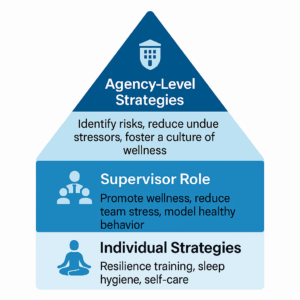
Law Enforcement Knowledge Lab: A Hub for Solutions and Innovation
Across America, from big cities to small towns, our law enforcement agencies are facing serious challenges. Whether it's recruitment challenges, violent crime, responding to major incidents, or ensuring the safety wellness of officers and staff, law enforcement agencies are facing serious challenges. But while the challenges may be immense, the solutions are out there—and they often come from within law enforcement itself.
At the Law Enforcement Knowledge Lab, we believe in the power of shared experiences. With more than 18,000 law enforcement agencies across the nation, no department is alone in the issues they face. The problems may be local, but the lessons learned and the solutions developed in one community can often help numerous agencies across the country. That’s why we’ve launched this conversation series—to highlight the innovative strategies, cutting-edge technologies, and promising practices that are making a real difference to improve public safety.
We know time is precious and these short Field Notes get right to the heart of the solutions. This isn’t just another abstract policy debate—it’s a resource built for those on the front lines and leading agencies’ efforts, offering practical solutions and insights in real time. Whether it’s a department pioneering a new training method, a city leveraging data-driven crime reduction, or an officer developing an innovative approach to community policing, we aim to spotlight those making an impact.
These conversations aren’t about theory—they reflect action. And it’s driven by law enforcement professionals who are committed to keeping America safe. So check back often, share your ideas with us, and let us know if there’s a department, a strategy, or an innovation that deserves to be in the spotlight.
Together, we can strengthen law enforcement and create safer communities. Let’s get to work.
Reducing Gun Crimes and Improving Community Relations in Knoxville

In late 2023, the Knoxville Police Department (KPD) officially launched its place-based strategy (PBS) zones, a violence reduction and community-building initiative designed to improve public safety and quality of life in areas disproportionately impacted by gun violence. The initiative is a data-driven, problem-solving approach that has proven effective at preventing gun crimes while simultaneously building authentic relationships in the community.
KPD’s initiative builds on the foundations of place-based policing by making a sustained, long-term commitment to select geographic areas. Additionally, the approach relies on partnerships with various City of Knoxville departments, service providers, and non-profit organizations to holistically address issues that contribute to crime, disorder and diminished quality of life.
Strategic Selection of PBS Zones
With the unified goal of meaningfully reducing gun violence in concentrated pockets of the community, KPD crime analysts conducted a comprehensive review of fatal and non-fatal shooting incidents. That review process, paired with input from community and department members, identified a 7.5-block area in the city’s East District that had experienced the highest number of shootings in the previous five years. The East District PBS zone was officially established as part of a pilot program in November 2023.
After a successful pilot period, the KPD expanded the program by adding two more PBS zones in mid-2024, one in the Central District and one in the West District.
KPD and its partners considered many factors when establishing the boundaries of the zones, including available resources, organizational capacity, and the unique needs of the selected areas. The zones that were identified were intentionally limited in size to ensure the initiative could be sustained long term and make a lasting impact.
Visibility, Collaborative Problem-Solving, and Measuring Outcomes
Central to the initiative is an intentional and consistent visible police presence in the form of vehicle, foot, and bicycle patrols. Front-line personnel assign directed patrols daily, with oversight from the district commanders.
Enforcement actions alone do not measure the effectiveness of directed patrols and police activity. Instead, officers conducting assigned PBS-zone patrols are given clear directives to positively engage with residents, help identify solutions for the issues identified in those communities and take enforcement action only when necessary.
City departments, such as the Office of Community Safety, Codes Enforcement, Public Service, and many community service providers have committed resources to the initiative and regularly contribute to the problem-solving efforts.
To effectively track and manage outcomes in the PBS zones and respond to changes in real time, KPD’s Crime Analysis Unit created PBS zone dashboards that update daily. The dashboards capture incidents, calls for service, directed patrols, and patrol results, including citizen contacts. District commanders are expected to report on activity within their respective PBS zone during weekly crime strategy meetings and make appropriate adjustments when outcomes do not meet expectations.
Sustainability Through Department Buy-In and Community Support
The success of the PBS initiative can be attributed in large part to the department-wide buy-in at all levels of KPD. From the outset, department members understood the purpose and intent of the PBS initiative. Most importantly, officers responsible for executing the vision were told the “why.” Nearly two years in, the initiative has now become a foundational piece of KPD’s culture and crime reduction strategies. KPD leaders continue to reinforce the importance of the initiative to officers and regularly share positive outcomes and resident feedback.
The initiative has resulted in a meaningful reduction in violence in PBS zones, as the East District PBS zone went over 16 months consecutively without experiencing a single fatal or non-fatal shooting. The intrinsic value of the initiative and philosophy at the heart of it has also revealed itself to officers who have experienced dramatically enhanced community relationships as they work to protect and serve the communities of Knoxville.
Authors:
Chief Paul Noel, Knoxville Police Department
Scott Erland, Communications Manager, Knoxville Police Department
Published August 6, 2025
A New Focus on Officer Wellness: Fargo Police Department Leads the Way

The Fargo Police Department (FPD) prioritizes officer wellness as a fundamental agency value, believing firmly that wellness initiatives and peer support are essential for both sworn and civilian staff, from the top down. Every one of our department team members feels the effects of the trauma and stress that is the unfortunate reality of our noble profession. Each performs their role and responsibility with fidelity on a daily basis. The work of our staff, sworn and civilian, is vital to organizational success and the ability to provide outstanding community service. We, as law enforcement leaders, have a duty to do all that we can to prepare and support them throughout their careers.
An Agency Commitment to Wellness
In 2024, the FPD hired a full-time wellness coordinator, funded by a grant from the Department of Justice’s Office of Community Oriented Policing Services (COPS Office). This significant investment followed the implementation of enhanced heart screening in 2023, annual mandatory mental health check-ins, resilience training through the VALOR program, and participation in the “Struggle Well” program that supports posttraumatic growth for officers. Also in 2024, the Department partnered with the National Policing Institute (NPI) on a sleep study for officers to better inform them regarding shiftwork and sleep patterns. More recently, in 2025, the FPD reintroduced annual physical agility tests, focusing on improving health rather than disciplinary measures. FPD plans to expand wellness efforts, proposing a Wellness Unit in the 2025 to 2026 budget.

Focusing on Learning and Improvement
To advance FPD’s continuous improvement in officer wellness, the Department partnered with the NPI as the first participant in an organizational stress study, funded by the National Institute of Justice, that will assist FPD in enhancing the current wellness approach through the development of comprehensive wellness strategies at multiple organizational levels. At the agency level, it is crucial to identify risks, reduce undue stressors, and foster a culture of wellness. Supervisors play a key role in promoting wellness and taking responsibility for reducing stress among their teams. On an individual level, initiatives such as resilience training and sleep hygiene are essential.
Through this program, officers who voluntarily participate in surveys and wear biometric devices receive personalized feedback about their levels of organizational stress, coping and resilience strategies, and how they compare to their peers in the agency. By analyzing the collected survey data paired with biometrics and administrative data, FPD will gain actionable insights and recommendations to improve the agency and officers' lives. This work also involves focus groups of personnel at all levels within the agency to identify strategies that reduce organizational stressors and mitigate their harmful impacts.
Boost Your Agency's Wellness Initiatives
FPD is committed to officer wellness and doing what it takes to support continuous improvement. Focusing on understanding organizational stress and its impacts on officers exemplifies a comprehensive, integrated approach to wellness. FPD has partnered with NPI to evaluate how these strategies can mitigate the adverse effects of organizational stress for law enforcement. This includes examining individual characteristics and behaviors, and their impact on health, wellness, and job performance outcomes. A description of the findings from this work will be available within the next year. For more information, contact the study's Principal Investigator, Dr. Karen L. Amendola or the NPI’s Knowledge Lab.
Author:
Chief David Zibolski, Fargo Police Department
Co-Principal Investigators:
Jennifer Rineer, Ph.D., Director & Research Psychologist, Workforce Wellbeing & Effectiveness Program, Center for Public Safety & Resilience, RTI International
Maria Valdovinos Olson, Ph.D., Senior Research Associate, National Policing Institute
Published July 2, 2025
Leveraging Expertise in Cancer Research to Increase Stolen Vehicle Identification

The Portland Police Bureau (PPB) is taking a fresh approach to tackling stolen vehicles, leading to a large jump in detection and recovery rates, while avoiding unnecessary vehicle stops. This innovative strategy was developed in collaboration with cancer researchers, making Portland, Oregon, one of the top cities in the nation for reducing vehicle thefts. Thanks to this approach, PPB recovers stolen vehicles in one out of every four targeted vehicle stops, compared to the previous one out of 31.
Understanding Vehicle Theft in Portland
In 2021, the Portland area was ranked fifth in the nation for vehicle thefts per capita, so PPB had a tough job identifying stolen vehicles before they were abandoned. Starting in January 2021, vehicle thefts in Portland surged, peaking in November 2021 with 1,140 reported stolen vehicles—an average of 38 per day. Officers noticed that stolen vehicles were often linked to serious crimes like homicides, armed robberies, and other gun violence, which had a major impact on the community.
Inefficiencies in Traditional Enforcement
To address this rise, PPB conducted overtime missions to locate stolen vehicles. These operations involved marked patrol units, plainclothes officers, canine teams, the Air Support Unit, and supervisors over a 10-hour period. While these missions recovered some stolen vehicles, they also resulted in many unrelated vehicle stops. PPB realized the need for a more targeted approach to improve efficiency and reduce unnecessary stops.
Innovation through Collaboration
The key to PPB’s innovation was a unique collaboration with cancer researchers from Oregon Health & Science University (OHSU). Using their data analysis and pattern recognition expertise, the team refined stolen vehicle identification and recovery efforts. They focused on identifying key patterns to determine what to prioritize and what to de-emphasize. This approach leverages information like vehicle characteristics (e.g., a broken window) and driving behavior (e.g., erratic driving or other road safety violations) to develop a list of “enrichment factors” that, taken together, play a key role in identifying possible stolen vehicles. he analysis findings were turned into actionable insights and shared with officers to improve their focus during stolen vehicle recovery missions. This process is continuously refined as new data emerge. The strategy of this approach is to focus on the crime and associated crime indicators rather than characteristics of the driver, leading to stops that are more focused, legally sound, and supported by the Portland community.
Positive Results
The new approach exceeded expectations, leading to a sharp decrease in vehicle stops and an increase in stolen vehicle recoveries. This success also extended to prosecutions, as officers used pattern analysis to build more substantial cases with compelling evidence. The data-driven approach has gained strong community support by enhancing transparency and clearly outlining the rationale behind vehicle stops and their outcomes. This increase in community support has resulted in a partnership with a volunteer-run group on social media, which includes over 20,000 members who help locate and report stolen vehicles in the Portland area.
Authors:
Officer Michael Terrett, East Precinct Neighborhood Response Team, Portland Police Bureau
Sergeant Bradley Nutting, East Precinct, Portland Police Bureau
Sergeant Cassandra Wells, East Precinct, Portland Police Bureau
Lieutenant Lacey Sparling, East Precinct, Portland Police Bureau
Commander Jake Jensen, East Precinct, Portland Police Bureau
Published June 18, 2025
District Champions: Miami Police Department's Bridge Between Innovation and the Field
 When the Miami Police Department introduces a new technology, the process starts well before the tool reaches officers' hands. Central to this approach is the role of the District Champion, a trusted field lieutenant selected to help implement innovation from the inside out.
When the Miami Police Department introduces a new technology, the process starts well before the tool reaches officers' hands. Central to this approach is the role of the District Champion, a trusted field lieutenant selected to help implement innovation from the inside out.
Deploying Champions Early
District Champions are activated early in the implementation process. They test new tools, offer real-world feedback, and serve as a communication bridge between frontline officers, analysts, IT units, and even external vendors. What’s new here is not just the creation of an implementation lead; it’s the timing and scope of the role. These Champions are engaged before a single login is created or a mobile device is issued. They help shape the rollout by listening closely to concerns and ideas from end users, particularly officers in the field.
This early listening role is critical. Champions gather input and concerns and relay them to technical staff or vendors for adjustments before full deployment. They are empowered to speak on behalf of their units and are respected by their units as such. As a result, when a District Champion says, “This will help us,” the buy-in from fellow officers is stronger and faster because the message comes from someone who understands the job and has their trust.
Fostering a Culture of Collaboration
Beyond implementation, District Champions also improve communication and facilitate the sharing of new ideas. Though they are field supervisors, they routinely facilitate collaboration across units, such as officers, analysts, and IT personnel, by creating a space where people are comfortable sharing ideas beyond their official roles. For example, an analyst might not just present a crime trend but might also suggest strategies to respond to it. A field sergeant might propose adding a new data field to an incident report to help detectives connect cases. These interactions build a culture of shared problem-solving and innovation.
Finding Your Champions
What sets successful District Champions apart is their ability to listen, translate feedback into action, and lead from within (not above) their units. They are respected by their peers and adept at navigating between the field and the command staff. Their credibility on the street lends weight to the new tools they help introduce.
Champions are most effective when they are already known as problem-solvers who elevate others' ideas. They are not just early adopters; they are early advocates, grounded in operational reality.
Signs of Success
One example captures the spirit of this role: In one Miami PD district, the officers awarded their District Champion a professional wrestling-style championship belt, declaring them the “best champion of implementation” for a new tool before the technology had even been deployed. The officers had such confidence in their Champion’s leadership and communication that they were already bought in. The message was clear: buy-in doesn’t have to wait until a product is in hand. It can start when the department commits to a new direction if the right people are trusted to lead.
Author
Commander Roger R. Jackson, M.A., Field Operations Division, Miami Police Department
Published June 4, 2025
An Internal Framework for Self-Assessment and Self-Correction Created by the Dallas Police Department

One year ago, the Dallas Police Department (DPD) launched a new unit to identify areas for long-term improvements, present opportunities for augmenting operational efficiency, and enhance public safety through innovation. The effort is positioned to create change from within by relying on system assessments rather than waiting for external pressure after a critical incident or court order to improve processes. As such, the unit views itself as a “best practice unit” that proactively identifies areas for improvement and implements best practices in accordance with the needs of the department, desires of the community, and innovations in the field.
How DPD Conducts Self-Assessment
The five core functions of the unit include independent analysis, implementation, monitoring, training and education, and officer and community engagement. The unit’s approach to independent analysis entails gathering information from officers, analyzing quantitative data, conducting field observations, reviewing processes and protocols, assessing policies, and undertaking reviews of the literature and best practices. The unit also partners with a criminologist who has previously worked with two major police departments to monitor and track their progress toward implementing constitutional policing practices and building community relations. The Criminologist in Residence assists in outlining the methodology for each review and conducts analyses of the Department’s data. This approach brings expertise to the department, balancing decision-making with an informed, external point of view.
After review and approval by DPD leadership, implementation can include changes to general orders and standard operating procedures, enhancements to internal systems or databases, and new or revised training. The unit guides the implementation of its recommendations, with a focus on the effectiveness of the implemented strategies.
Achievements of the Approach
During the first year, the new unit, called the Constitutional Policing Unit, completed three reviews, with more planned for the upcoming year. One example of a review involves the Internal Affairs Division’s (IAD’s) investigation processing times. Shorter IAD investigations can help foster transparency, improve perceptions about how the incident was handled, and benefit officers by providing a timelier resolution. The unit’s review resulted in four primary findings and 17 recommendations to add efficiencies and streamline processes, all of which were reviewed and approved by DPD leadership and are in the process of being implemented. Other reviews include assessments of the Department’s motor vehicle stop data program, use of force system and data, and Special Response Group responsible for responding to First Amendment demonstrations and instances of civil unrest. The 12-person team of professional and sworn staff is building a framework and processes to promote a culture of continuous learning and improvement by engaging in self-assessment and self-correction.
Hopes for the Unit
The DPD hopes to foster operational innovation, enhance efficiency, and encourage evidence-informed decision-making as it reshapes law enforcement practices to protect civil rights, bolster trust between communities and officers, and promote public safety. The progress and learning from early experiences of this unit are worth keeping an eye on.
Author
Andrea M. Headley, Ph.D., Affiliated Scholar, National Policing Institute.
Published May 21, 2025
A Problem-Oriented, Place-Based Approach Results in Crime Reduction in San Antonio
 The City of San Antonio and the San Antonio Police Department (SAPD) are employing a new problem-oriented approach to violence reduction at one of the city’s most violence-prone apartment complexes. After six months, this approach has reduced violent street crime by 50% compared to the year before. Overall, calls for service were down 24%, and violence-related calls by 30%. This problem-oriented, place-based policing (POPBP) approach aims to reduce crime in some of the city’s persistently violent places by building on a foundation of problem-oriented policing and incorporating a multi-disciplinary team of stakeholders from across city government and the identified place.
The City of San Antonio and the San Antonio Police Department (SAPD) are employing a new problem-oriented approach to violence reduction at one of the city’s most violence-prone apartment complexes. After six months, this approach has reduced violent street crime by 50% compared to the year before. Overall, calls for service were down 24%, and violence-related calls by 30%. This problem-oriented, place-based policing (POPBP) approach aims to reduce crime in some of the city’s persistently violent places by building on a foundation of problem-oriented policing and incorporating a multi-disciplinary team of stakeholders from across city government and the identified place.
Although this approach had positive findings, understanding its overall impact is still being considered. Family violence offenses and calls increased compared to the previous year, suggesting that more work remains to be done at the site to change patterns of violent behavior within intimate partner and family settings. It’s also possible that increased trust by residents in the responses they have seen from the city in their community has increased their willingness to report. San Antonio’s efforts at the site will continue as it pivots to its next POPBP site in 2025.
How the Approach Works
The POPBP approach employs a multi-disciplinary team to diagnose the proximate causes of recurring violence at the location of interest and implement creative solutions. POPBP expands upon the Goldstein (2015) data-driven SARA approach (i.e., scanning, analysis, response, assessment) to include multiple government agencies and local stakeholders that have a potential role in using data analysis findings to identify long-standing problems that help contribute to crime at a location. Local stakeholders, such as apartment complex owners and managers, are vital to the strategy's success.
How POPBP is Carried Out
An operations plan was created for the first POPBP site, outlining the identified problems, solutions, responsible parties, timeline, and action steps, and metrics for success – both implementation and effectiveness. This plan was developed under the leadership of the deputy city manager and director of the city’s Integrated Community Safety Office, agency directors representing the SAPD, City Attorney’s office, Metro Health, Human Services, Animal Care, Parks and Recreation, Solid Waste, Neighborhood Housing Services, and Public Works & Planning. The group initially came together in spring 2024 to choose the first POPBP site from a short list of persistently violent places identified by research partners at the University of Texas at San Antonio (UTSA). Once the initial site was chosen – a San Antonio Opportunity Home property – directors from this diverse set of agencies assigned managers to serve on a working group to analyze data, make site visits, survey residents of the identified apartment complex, identify problems, and develop solutions. The working group created the framework for the plan.
The plan was put into action in June 2024, starting with a resident survey and including a range of efforts to address resident access to city services, problems with stray animals, homelessness in the area, trespassing on the property, improvements to lighting, truancy reduction, violence reduction workshops, trash removal, and repair to physical infrastructure, including sidewalks and fence gates, to help control unauthorized access to the property.
How Success is Measured
Implementation and impact data are captured and reported monthly to the UTSA research partners through an easy-to-use electronic form. The UTSA team conducted an independent implementation and impact evaluation of the city’s POPBP efforts and detailed its findings in a public report and presentation to the Public Safety Committee of the San Antonio City Council.
Where POPBP in San Antonio Stands Now
Noting the reduction in reported violent crime, violence-related calls, and overall calls for service, the City of San Antonio and SAPD continue the POPBP model and plan to add a second site in spring 2025. The work in San Antonio reinforces the continued evidence that data-driven strategies, including POPBP, work to reduce violent crime and highlight the innovative approaches that research partners can bring to the crime fight. A crucial finding of this work is the need to layer evidence-based practices to address the problem at its root. For more information about this work, please see the second year of the San Antonio Violent Crime Reduction Plan's evaluation, or contact the Knowledge Lab.
References
1 Goldstein, H. (2015). Problem-oriented policing. New York: McGraw-Hill.
2 Smith, M., Tillyer, R., Tregle, B., Cardwell, S.M., Fahmy, C. (2024). San Antonio Violent Crime Reduction Plan: Year 1 Evaluation. University of Texas at San Antonio. https://hcap.utsa.edu/documents/criminal-justice/sapd-plan-y1-report.pdf
3 Smith, M., Tillyer, R., Tregle, B., Cardwell, S.M. (2025). San Antonio Violent Crime Reduction Plan: Year 2 Evaluation. University of Texas at San Antonio. https://hcap.utsa.edu/documents/criminal-justice/final-sapd-y2-report-2.19.25.pdf
Author
Michael Smith, J.D., Ph.D., Professor, The Department of Criminology and Criminal Justice, The University of Texas at San Antonio.
Published May 7, 2025
Latest Resources
Visit the Knowledge Lab's full resource index
Guidebook/Tool | 2024
Preparing Law Enforcement Agencies for Embedded Clinicians
- Community Trust and Partnerships
- Mental Health and Crisis Response
After Action Report, Guidebook/Tool, Report | 2024
Critical Incident Review Active Shooter at Robb Elementary School
- Crime and Violence Reduction
- Community Trust and Partnerships
Guidebook/Tool | 2024
Operationalizing Proactive Community Engagement: A Framework for Police Organizations
- Community Trust and Partnerships
- Public Transparency
Guidebook/Tool | 2024
Considerations for Specialized Units
- Community Trust and Partnerships
- Public Transparency
Report | 2024
Monitoring Law Enforcement Consent Decrees: An Introduction and Starter Toolkit
- Community Trust and Partnerships
- Use of Force
Report | 2024
- Community Trust and Partnerships
- Public Transparency
Report | 2023
Dispatching Community Responders to 911 Calls
- Crime and Violence Response
- Community Trust and Partnerships
- Mental Health and Crisis Response
- Responding to Mass Critical Incidents
Guidebook/Tool, Video, Other | 2023
Community Based Violence Intervention and Prevention Initiative (CVIPI)
- Crime and Violence Response
- Community Trust and Partnerships
Empowering Law Enforcement Excellence
A Beacon of Guidance at the National Law Enforcement Knowledge Lab
Explore targeted areas such as crime and violence reduction, use of force accountability and early intervention, and recruitment and retention. Elevate your agency's performance with our guidance and support.




